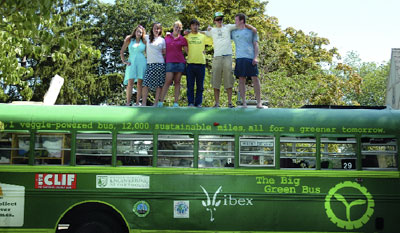The Greening of Wellesley and Weston
Lisa Leslie Henderson writer
Things are turning green. It is spring in New England and the dormant, now-grey hues of winter are being supplanted by vibrant shades of emerald, jade, olive, and lime. But this year, perhaps more than ever, many Wellesley and Weston residents are seeing green in places they have not before.
 “There has been an incredible ground-swell of interest in energy efficiency and conservation during the past six months—more than I have seen in the previous 13 years combined,” observes Richard Joyce, Director of the Wellesley Municipal Light Plant (MLP), the town department responsible for the transmission and supply of electricity to local residents, businesses and colleges.
“There has been an incredible ground-swell of interest in energy efficiency and conservation during the past six months—more than I have seen in the previous 13 years combined,” observes Richard Joyce, Director of the Wellesley Municipal Light Plant (MLP), the town department responsible for the transmission and supply of electricity to local residents, businesses and colleges.
The combination of higher energy prices, a broader awareness of global warming and environmental damage, a desire for healthy homes, and clearly identifiable ways of taking action are facilitating this growing interest. After the town of Wellesley reached an all time electric-consumption high of 65,076 kilowatts on August 2, 2006, the MLP is beginning to see energy usage going down.
“There is a saying: the greenest kilowatt-hour (kWh) is the one that is never generated,” says Joyce. Toward this end, one year ago the MLP earmarked $500,000 in seed money to fund energy efficiency and conservation initiatives in town. The first project included the replacement of incandescent light bulbs with compact fluorescent units in the Town Hall, Fire Station, Department of Public Works, and at Hunnewell and Hardy schools, a venture that is saving six figures over the next four years.
“It’s very rewarding—the savings we are experiencing replenish the fund, so there is money available for future projects,” explains Joyce. The annual reduction in CO2 emissions, which are released during the energy conversion process, from this undertaking alone is equivalent to removing 34 cars from the road each year.
Other institutions in the area are going green and realizing the benefits. In an attempt to reduce its annual utility budget, which hovers around $4.1 million, Babson College students and the Office of Facilities have made several changes including instituting the “dark dorm” competition. Dorm dwellers are encouraged to reduce their energy and water use by turning out lights, taking shorter showers, turning down the heat, and unplugging unused electronics; each month the winning dorm is awarded a pizza party.
Last year, Babson’s Putney Hall was able to decrease its energy consumption by 20 percent, but the real winner was the College, which saved $28,000 from the dorms’ collective efforts. When you consider that $1,700 of a typical Babson College student’s tuition dollars are allocated toward energy, you can begin to appreciate the financial motivation for green initiatives.
The Cambridge School of Weston (CSW) has taken the green challenge one step further with the opening of its 21,000-square-foot green Garthwaite Center for Science and Art. Designed by Boston-based Architerra, Inc., the building incorporates multiple green features from radiant floor heating to a green roof, and several processes and systems in between.
“One of our goals for the building was to be an icon of earth stewardship, which has been a integral part of our curriculum for some time,” recounts Jane Moulding, Head of School.
“The building challenges us,” observes Marilyn DelDonno, Head of the CSW’s Science Department. The Garthwaite Center is often referred to as a FTE—full-time equivalent teacher—because, from its inception, it has stimulated an inclusive, iterative learning experience for the CSW community. Students, parents, faculty, community members, and experts contributed to its design, and students are now measuring its energy efficiency to see if the structure lives up to expectations.
Even visitors to the school come away different. As Moulding observes, “When you walk in [the building], you are in the presence of something unusual—you feel it right away. Many of the building’s systems and green features are exposed. It asks you to consider what you can do differently.”
Several local residents are thinking differently when it comes to building and remodeling with the environment in mind. Wellesley resident Tedie Bastian and her family are building a green home. “I thought if we could build the most energy-efficient house possible, it would pay off in the long run,” Bastian says. “Besides, I believe in supporting green technologies as they become more prevalent in the construction industry.”
Their home will take advantage of geothermal technology, which harnesses the constant temperature of the earth in the heating and cooling of their home. “We are also super-insulating our home—it is one of the best things we could do to save on energy consumption,” says Bastian.
Weston resident Allison Friedman embarked upon a green renovation two years ago, which proved to be quite a challenge. “Although we had some green success stories with our home—recycled decorative tiles, recycled denim insulation, farmed woods for kitchen cabinetry, green paints, and smart house technology for regulation—we didn’t really know enough at the time to build an eco house,” Friedman recalls.
As a result of her experience, Friedman co-founded Rate It Green, an online community for anyone interesting in green building. Users can review others’ experiences with green products and services, and can offer their own opinions and ratings.
“Our goal is to create the most robust directory of products and services for those who are interested in green building,” explains Friedman. “We want it to be easier to make design and purchasing decisions and to buy green confidently.” In this emerging field, it is important to be able to determine which eco-friendly products work well, and which green-labeled products are legitimately better for the environment.
Green practices are also taking place outdoors. The well-manicured lawns characteristic of our towns typically require fossil fuels, chemicals, and significant amounts of water. A typical gasoline-powered lawnmower produces as many hydrocarbons in an hour as is produced by driving a car 200 miles. Wellesley resident Andy Macalaster took this energy challenge to heart and, with the help of a classmate, built a bio-diesel-processing unit at Noble and Greenough School as an alternative way to power lawn equipment on campus.
“Bio-diesel is a domestic, renewable fuel for diesel engines that is derived from natural oils like soybeans,” describes Macalaster. “My friend spent a term studying at the Island School [in the Caribbean] where they have a huge bio-diesel system, powered by vegetable oil from cruise ships. We wanted to recreate the technology here.”
Macalaster and his friend were successful. With oil they procured from YAMA, a Japanese restaurant in Wellesley that had been paying a fee to have the oil removed, they created a new and renewable energy source for the school.
Another Wellesley resident, Kate Parizeau, spent last summer traveling across the country in a school bus that was powered by waste vegetable oil. She and eleven other Dartmouth students spent 11 weeks on the road in the “big green bus,” covering 13,226 miles and utilizing 2,226 gallons of waste vegetable oil to raise awareness of renewable energy options. Their motto: Change your fuel, change the world.
Janet Bowser, Director of Wellesley’s Natural Resource Commission might add, “Change your lawn care program, change the world.” Through its Pesticide Awareness and Organic Land Care Education Campaign, the Commission is raising awareness about environmentally-friendly ways to maintain lush lawns. “People think that if they go organic they will have to lower their expectations,” Bowser explains. “But it is just not true. The town has been using organic lawn care programs on its conservation properties, park land, and non-school playgrounds since 2002.”
Grey Lee, Director of Land’s Sake farm in Weston would agree. Land’s Sake has been growing fruits, vegetables, and flowers using organic methods for almost thirty years. Many Wellesley and Weston residents enjoy the benefits of eating locally-grown food; several also take advantage of Land’s Sake’s expertise to help with ecologically-minded residential landscape installation, maintenance, and reclamation projects.
Lee grew up volunteering at Land’s Sake, an opportunity from which hundreds of children in Weston have benefited, through the Farm’s education initiatives and community partnerships. “Sadly, sometimes these programs are kids’ first exposure to the natural world,” says Lee. “Being close to the earth is what sustains us. We have to get back in tune with the natural cycle of the land otherwise we feel disconnected. Passing on this knowledge to the next generation is what community is about.”
One of Lee’s former classmates from Weston High, Peter Haas, is passing on his knowledge of green technology to people throughout the developing world. As a Founder and Executive Director of the Appropriate Infrastructure Development Group (AIDG)*, Haas sees a profound link between poverty and sustainability.
“Most people that live in abject poverty—surviving on between $1 and $4 a day—pay a lot more than we do for really basic things,” Haas explains. “In terms of energy consumption, a typical family in a developing country pays roughly $8 a kilowatt-hour, compared to the $.30 to $.40 cents we pay per kWh. These people have limited access to resources—the grid will never reach them—so renewables are their only solution.”
AIDG empowers communities with simple technologies manufactured from materials that are available locally, an essential factor to successful long-term infrastructure. Last summer, 10 students from Weston High were able to build and install clean-burning stoves and a bio-digester, which converts animal waste into usable methane fuel, in two communities working with AIDG in Guatemala.
“These technologies can be built with limited capital and without harming the environment,” offers Haas. “We are giving rural communities the chance to solve their problems themselves, without a major government public works project that may never happen.”
Fourth-graders Lucy Elwy and Mary Katherine Milway are taking matters into their own hands here at home. Laminated signs from their recently launched campaign to pick up trash in their neighborhood park in Wellesley remind us that, “Green Grass is Good.”
While these eco-efforts taking place within the Wellesley and Weston communities may seem small individually, they are leading the green movement to a tipping point. “People mistakenly believe that one person can not make a difference,” observes Bowser. “But the greatest impact happens at the local level.”
* For more information on AIDG, see “Good Works” in WellesleyWeston Magazine’s Summer 2007 issue.


recent comments